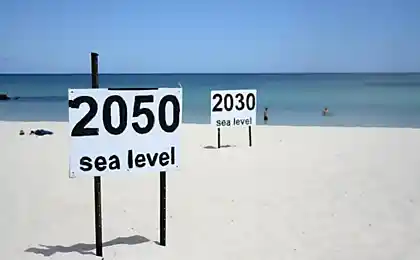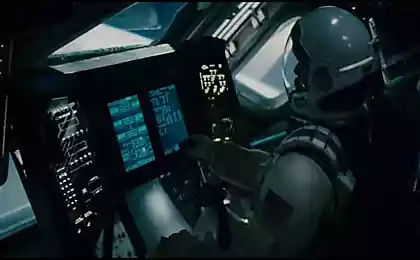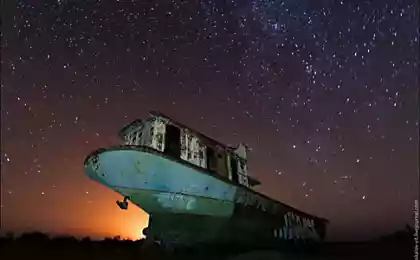909
4 technology, which will help save the oceans

The Ocean Cleanup - Barriers to collect floating debris i>
People are destroying the oceans. But technology can help. This article will tell you about the 4 projects that are helping to save the oceans from destruction.
In 2010, the oceans were dropped more than 8 million tons of plastic . To understand what kind of amounts, imagine that on every square meter of coastline threw plastic bottles of 5-6. Earlier this year, a study was published, according to which the amount discharged into the oceans of plastic waste in the coming years will increase 10 times, adding to the weight of the current ocean of garbage in 245, 000 tons.
However, not only environmental pollution has a negative effect on the oceans and seas. At risk is the sheer variety of life forms in the oceans - the coral reefs are dying because of the rising acidity of the oceans. По UN forecasts , if the trend will not change, by 2100 more than half of marine species are threatened with extinction. In addition, sea level gradually rises due to global warming. According to the calculations of the National Oceanic and Atmospheric Administration, each year the level of the world ocean increases of 1 to 3 centimeters, with a tendency to increase pronounced.
Technologies have already started to play a greater role in the movement for the preservation of the environment, conservation of existing natural conditions and rationalization of food resources. Satellites and underwater robots already being used to study the oceans. And what about their salvation?
Let's look at 4 technology, which can help us clean up and protect the sea and the life in them.
The project The Ocean Cleanup h5> Currently, a full and comprehensive cleaning of the oceans seems to be something impossible. Even if you collect floating debris ordinary networks, the need to spend tens of billions of dollars and a couple of thousand years. However, at one point, the guy twenty years (Boyan Slat - approx. Interpreter i>) tired all this garbage and it has launched a project The Ocean Cleanup . The essence of the project is that floating on the ocean surface debris will be collected in a natural way: the garbage will accumulate at specific barriers under the influence of currents. Such an approach would not only effectively collect floating debris, but does not harm the sea creatures that can swim under it, without falling into the network. Gathering barriers will be stretched between the stationary platforms that will cover a huge area. Several pilot plants with barriers will be installed in coastal waters as early as this or in 2016. It is assumed that the length of the assembly of the barrier is about 2 kilometers.
Marine robots h5> For many years, scientists have used robots to study the deep sea. Now they can already use robots not only under, but also on the water. Robots equipped with various sensors and instruments can take samples, take photos, explore the seabed and its inhabitants. An example of a modern robot Wave Glider SV3 , autonomous robot company Liquid Robotics, runs on solar energy. SV3 - an updated version of its "little brother" SV2. To move SV3 uses are endless reserves of energy of the oceans. SV3 may collect the necessary data to one year. Both robots are equipped with Wi-Fi and a large amount of memory. SV3 can explore more than 90% of the world ocean and swim to where they could not get even more robots, not to mention the people.
"Smart" network h5> Each year the oceans dropped a huge number of dead fish. This fish was too young or too small to go into use. It could properly catch and the fish just died of stress. While most of the world's population eats fish is, the practice of mindless use of resources is unacceptable. However, this problem is finally engaged. Scientists with several fishing companies in New Zealand have launched a project called Precision Seafood Harvesting . The meaning of the project to use high-tech trawl nets to catch some type of fish, instead of the usual huge networks, which gets everything in their path. This allows you to take care of the fish even if the fish caught, hitting the ship, it floats in special containers, which reduces stress and the level of damage, helping the fish to survive. Company Safety Net Technologies also developed a trawl net that allows the network to catch only the fish, not the other inhabitants seas and oceans. Such a network can be quickly upgraded for use with the existing fishing equipment. It allows you to spend less fuel and, most importantly, to reduce damage to the seabed. Moreover, the network is provided with special rings that allow small fish to swim out.
Marking animals h5> In the last decade, marking the animals made a huge step forward. A recent report in the journal Science showed that the effect of labeling on the lives of the inhabitants of the seas difficult to underestimate. Electronic beacons are very small and weigh less than a small coin, but, nevertheless, presents full data on the movement of animals, their migration and interaction with each other. Satellites tracking stations and read information from the beacon for more than 10 years. The good news is that the beacon can be attached to almost any animal, no matter how small it may be. High-tech beacons are very important to monitor the vital functions of bluefin tuna. The popularity of sushi with this type of fish has led to the fact that the annual catch exceeds the norm.
Translations prepared: greebn9k (Sergey Gribnyak), silmarilion (Andrew Haharev)
Source: geektimes.ru/post/259252/
Kepler-452b. Another "double" in the constellation Cygnus. The first extrasolar planet, whose existence is not contested
15 amazing cities built on the rocks























